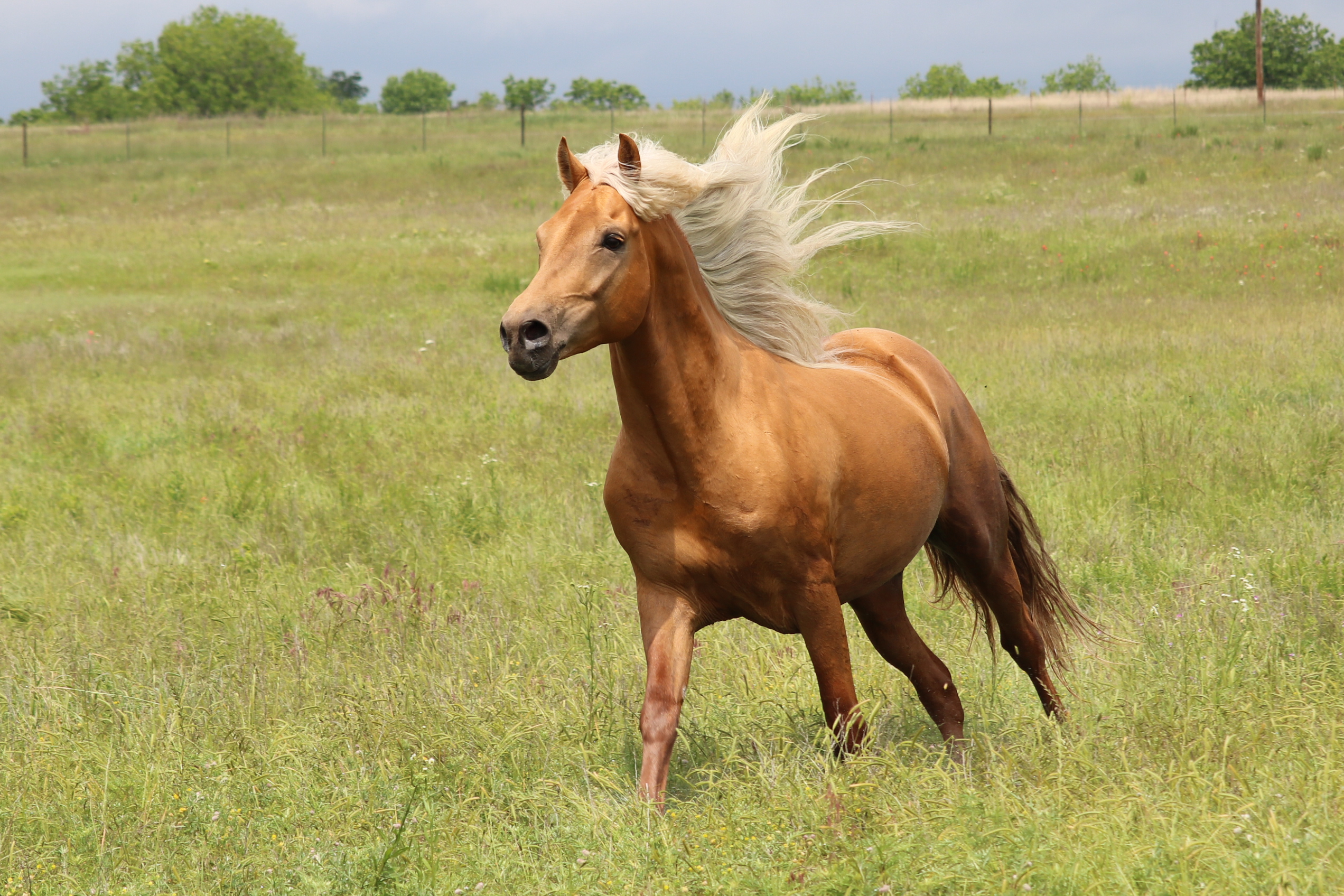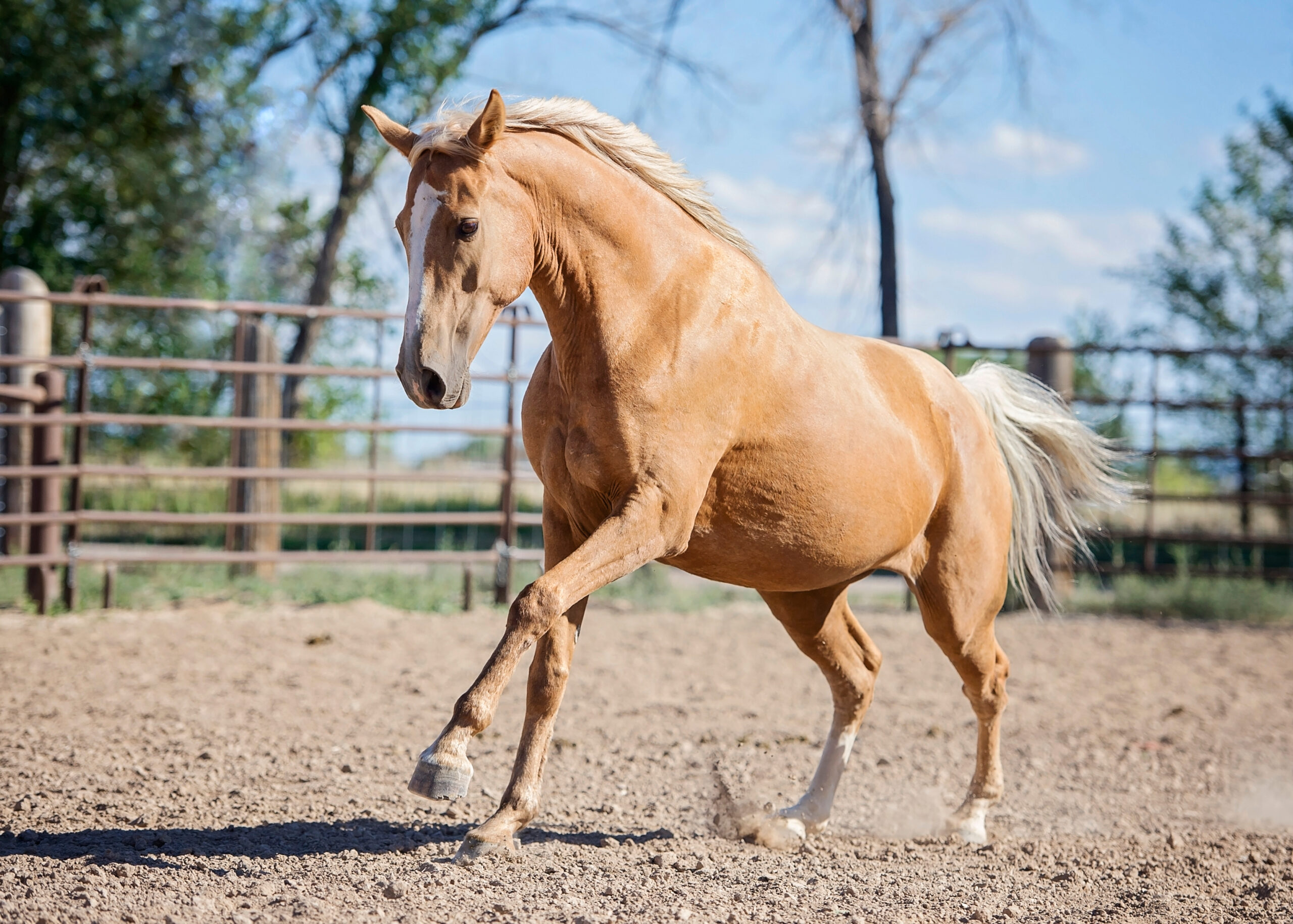Palomino describes a color, rather than a breed of horse. This gorgeous golden coloring occurs in many different breeds of horse and pony. Having said that, Palomino Horses are so popular that lots of registries and organizations exist just for horses of this color. Every Palomino Horse has a golden coat, though the actual shade may vary.
Palomino Horses – History and Origins
Palomino as a horse color has undoubtedly been recognized for centuries, but not necessarily by this name. Shimmering golden coats have long been associated with horse breeds such as the Akhal-Teke. Many of the horse breeds of the Caucasus show this characteristic, too. Golden horses appear frequently in legendary accounts. The sun god of Greek and Roman mythology drove his chariot through the sky harnessed to fiery horses. One of the steeds of the Greek hero Achilles was called Xanthos, which might be translated as “Golden One,” or even “Blondie!” We can assume that his horse was as attractive as modern Palominos. It wasn’t until the sixteenth century that horses with this color began to be given a name and identity.
The story goes that they were first called Isabellas after the Queen of Spain who was said to adore horses of this coloring. However, some historians disagree with this. They point out that the word Isabella was used to describe fabrics of a yellow-gray color before her reign. It does appear to be true that Queen Isabella (or Ysabella) loved pale golden horses, and that she allegedly gave a stallion and five mares to be foundation stock in Mexico. Then a Spanish nobleman and conquistador, Juan de Palomino, made his entrance into the story, allegedly loving the coat color as much as Isabella, and so the horses he bred acquired his name.
However, it is also true that Palomino is the name of a yellow-gold variety of grape. It would, therefore, not be surprising if luscious golden horses also acquired that name. Yet another story suggests that Palomino derives from the Spanish word Paloma, meaning dove. This, too, makes sense, considering the rich warmth of Palomino coloring, and the gentle, luminous eyes of the horses with this coat.
What breed of horse is a Palomino?
Palomino is a color and not a breed, so horses of many different breeds can be Palominos.
What Gives the Palomino its Stunning Coat Color?
They all have contrasting silvery or yellowish-white manes and tails. Many have white socks and a white blaze or other facial markings. Another thing that is common to all Palominos is that they draw attention wherever they go! There are few horses more eye-catching than a Palomino Horse with its golden coat and white markings flashing by. That’s why they have always been a popular choice for parades and many have starred in movies and TV series.
This lovely coat color is due to an interesting genetic factor. It’s the result of a cream dilution gene working on a technically “red,” or rather, chestnut or sorrel base coat color. The effect of the dilution produces a golden shade similar to a gold coin. In fact, up to five different shades of gold color exist in horses in Palomino registries. Coat color can vary from winter to summer. Cremello coloring results from a double effect of the same gene, and this can result in blue-eyed horses with very pale coats.
Many horses look as though they might be Palominos, but in fact, they aren’t. Haflingers, though they have rich golden coats and flaxen manes and tails, are not true Palominos as they do not carry the cream dilution gene. They are, in fact, chestnuts with a flaxen mane and tail.

Palomino is a color and not a breed, so horses of many different breeds can be Palominos.
Palominos: Stars in Their Own Right
Whatever their origin and antiquity, today, Palomino Horses are firmly established as some of the world’s favorite horses. The color is particularly associated with American horse breeds, mainly because of their popularity in Westerns. Palominos can be found in the American Saddlebred, Tennessee Walking Horse, Morgan, and Quarter Horse breeds. Welsh Ponies and Cobs, some Arabs, and other well-known breeds can also be Palominos. They are particularly popular in the media. There have been many famous Palominos, from Roy Rogers’ horse Trigger (in fact several horses with the same coloring played the part!) to Champion the Wonder Horse. It’s interesting that all Palomino Horse stars exhibit great intelligence and are capable of performing some amazing feats.
Mr. Ed, the Talking Horse, was one of the most famous Palominos ever. The wisecracking Ed starred in 143 episodes of his own TV series in which he constantly got the better of his human, Wilbur. Sadly, the TV series was made in the days of black and white television, but it’s still possible to tell that Ed, in reality, a horse called Bamboo Harvester, is a true Palomino. More recently, Argo the steed of Xena, Warrior Princess, was a Palomino. It’s also interesting that many Palominos are extremely long-lived horses.
Video of Palomino Horse
Requirements for Registration
Registering a Palomino can be complicated. Acceptable qualities vary from organization to organization. Horses with Palomino coloring have existed for centuries, possibly even thousands of years. However, the way genes produce this color has only been understood in recent years. This resulted in horses with Palomino color being recognized as a “color breed,” which is a more accurate description than a true breed. In the USA, the Palomino Horse Association (PHA) accepts Palomino-colored horses and ponies of all breeds and types on the basis of their color and conformation alone.
The Association’s acceptable range of color is based on the standard of the gold coin, with variations from light to dark. Manes and tails can be shades of white, silver, or ivory. The PHA also accepts Cremello horses with blue eyes, although genetically these are not true Palominos. The Palomino Horse Breeders of America (PHBA) only registers Palomino-colored horses whose parents are registered with certain breed registries. Many of these are famous American breeds, such as the Quarter Horse, Morgan, Saddlebred, Paint, Pinto, and Appaloosa. It may seem odd to see the other color registries in there. However, since Palomino is produced by a non-dominant gene, it is possible to produce a Palomino from horses, which carry but don’t display the gene or are crossed with a Palomino.
The PHBA also accepts other registered breeds, such as the Holsteiner, Arabian, part-Arabian, and Thoroughbred. Gaited horses are accepted, too. Once within the registry, the offspring of registered horses can be automatically entered as long as they meet the PHBA’s color and other standards. The PHBA does not accept Cremello Horses and has strict standards on white markings. There are height restrictions too. To enter the registry, horses must be between 14 (56 inches/142 cm) and 17 hands high (68 inches/173 cm).

Palominos are height restrictions too. To enter the registry, horses must be between 14 (56 inches/142 cm) and 17 hands high (68 inches/173 cm).
What are Palominos known for?
Palomino Horses are famous for their beauty, due to their gorgeous gold color with contrasting mane and tail.
Palomino Horses – Basic Color Variations
Four main types of Palomino coat color are recognized. Here’s how to spot them:
- The first one, light Palomino, is the closest to Cremello. These horses have pale-colored coats with white manes and tails. They are a beautiful sandy cream color that could be easily mistaken for some Cremello Horses at a distance. However, like all true Palominos, the light Palomino has dark skin, whereas a Cremello has pink skin. True Palominos always have dark eyes.
- Golden Palomino Horses have the classic gold coin coloring, usually with a white mane and tail. They may change colors according to the season. Intense sunlight can also have an effect on Palomino coats, as with other colors.
- Chocolate Palominos, as the name suggests, are a rich, warm, golden chocolate color, sometimes with a yellow-white mane and tail. It’s the outcome of crossing a liver chestnut horse with a Palomino and is a rare and treasured coat color.
- The unusual Pearl Palominos occur as the result of the rare pearl dilution gene, which is found in Iberian breeds, including the Andalusian and Lusitano. Various breeds, such as the Quarter Horse and Paint Horse, and some of the gaited breeds like the Peruvian Paso, can carry this gene. As they are descendants of Iberian horses, this is the likely source of this genetic mutation.
What is a Palomino Horse used for?
Since Palomino coloring is present in many breeds of horses, Palominos come in all shapes, sizes, and temperaments. This means Palominos participate in every equestrian sport as well as taking ribbons in the show ring. Palomino Horses star in movies, TV shows, and parades and are a great choice for Western classes.

